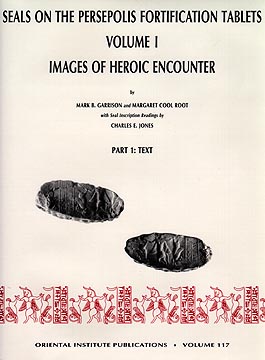OIP 117. Seals on the Persepolis Fortification Tablets, Volume I: Images of Heroic Encounter Mark B. Garrison and Margaret Cool Root
- Download Part 1. The Text
- Download Part 2. The Plates
- Terms of Use
This is the first volume (text and plates) of the analytically legible seals (ca. 1,162) retrieved through many thousands of full or partial impressions preserved on the 2,087 Elamite administrative tablets recovered during the 1930s excavations at Persepolis, Iran, and published by Richard T. Hallock (OIP92) in 1969. The tablets are dated by date formulae in the texts to the years 509-494 B.C. in the reign of Darius the Great. The remaining and forthcoming two volumes are entitled: Seals on the Persepolis Fortification Tablets, Volume II: Images of Human Activity Seals on the Persepolis Fortification Tablets, Volume III: Animals, Creatures, Plants, and Geometric Devices. Volume I introduces the archive and documents the 312 seals of heroic encounter (retrieved via 1,970 impressions) with high quality composite drawings and a separate volume of 291 halftone and line plate illustrations presented at a scale of 2:1. Entries provide commentary on administrative, social, stylistic, and iconographical features of the seals as well as systematic analysis of seal application patterns. The thirty-four seal inscriptions are presented by Charles E. Jones. Twelve appendices richly synthesize formal and iconographical data and integrate the seals with their associated texts. This major corpus offers extraordinary new material for the study of art and social history in the Achaemenid Persian Empire.
Two volumes (Text, Plates).
- Oriental Institute Publications 117
- Chicago: The Oriental Institute, 2001
- ISBN 1-885923-12-0
- Text volume - Pp. xxxiii + 562; 25 charts, 9 figures
- Plate volume - 291 plates
- Clothbound 9 x 11.75 in / 23 x 30 cm
- $140.00
Selections from the Introduction
This volume is the first of a projected three-volume catalog of glyptic evidence on the art and social history of the Achaemenid Persian Empire (ca. 550-330 B.C.), particularly during the reign of Darius I. The catalog documents the approximately 1,162 analytically legible seals retrieved through the collation of many thousands of impressions preserved on the 2,087 Elamite administrative tablets published by Richard T. Hallock in 1969 (hereafter referenced as the PF tablets or the PF corpus). These tablets are dated (by means of date formulae in many of the texts) to the period 509-494 B.C., within the reign of Darius I. In Volume I alone, the catalog presents 312 distinct seals reconstituted from a grand total of 1,970 complete or partial impressions. [from page 1]
The Fortification archive consists of inscribed tablets and also uninscribed (but sealed) tablet artifacts. Published estimates of the total number of extant clay tablets (both inscribed and anepigraphic) range between 20,000 and 30,000. These figures are only approximate, in the absence to date of a systematic and comprehensive inventory of all the tablets and tablet fragments. Variation depends to some degree upon how the fragmentary tablets are counted and the number of undetected joins that may shrink the number of individual tablets. Whatever the precise tally, the Fortification archive remains one of the largest dating to the first millennium B.C. so far excavated in ancient western Asia. The uninscribed but sealed tablets number in the thousands. Unofficial estimates have suggested that these may account for up to half the total number of clay artifacts in the archive. If this suggestion is roughly accurate, it still leaves approximately 15,000 complete and fragmentary inscribed tablets. [from page 3]
In western Asiatic glyptic the heroic encounter is among the earliest figural representations, beginning in prehistoric times and weaving in and out of the tradition down through the Sasanian period. Initially, the motif must have signified direct aspects of human interaction and power relationships with the animal world; it must have alluded explicitly to the agency of humankind in its primordial grappling with the forces of nature. But even on the earliest figural stamp seals of Mesopotamia and Iran the hero image is likely also to have symbolized emerging ideas of authority translated from the explicit level of represented meaning to a more abstract metaphorical level of human intervention, prestige, and mastery within the domain of human affairs. Some scholars emphasize links to cult and divinity embedded in the heroic vision, as opposed to links with the pragmatics of power and control of resources implicit in an increasingly complex social ecology. There is, however, no need to consider these factors as mutually exclusive. To some extent the motif probably never lost its primeval essences, even as it developed increasing metaphorical capacities. [from page 53]
From the entire known repertoire of official Achaemenid sculpture depicting a human-form protagonist, the hero motif is the only one that is also a quantitatively significant theme on seals of the period. In monumental art, the theme is restricted to the combat encounter. The occurrence of the heroic combat in official monumental contexts may help elucidate the identity, meaning, and evident prestige of this form of the image on Achaemenid seals. (By extension, it may help us to understand the meanings that would have been re-invested in an antique seal of this type used within the milieu of the Achaemenid court.) [from page 56]
The material assembled in this catalog for the first time needs to speak for itself and to invite deeper inquiry into meanings of heroic encounter in the Achaemenid Empire from a variety of scholars according to agendas including, but certainly not limited to, those we have suggested herein. [from page 60]


